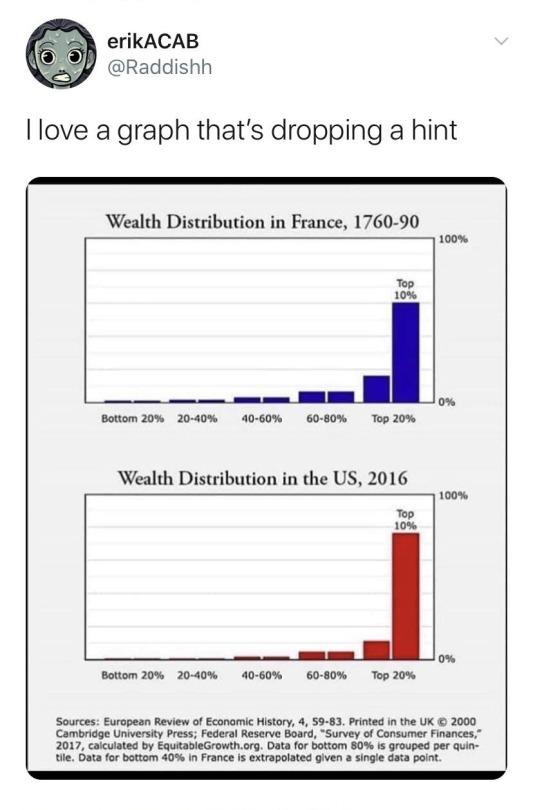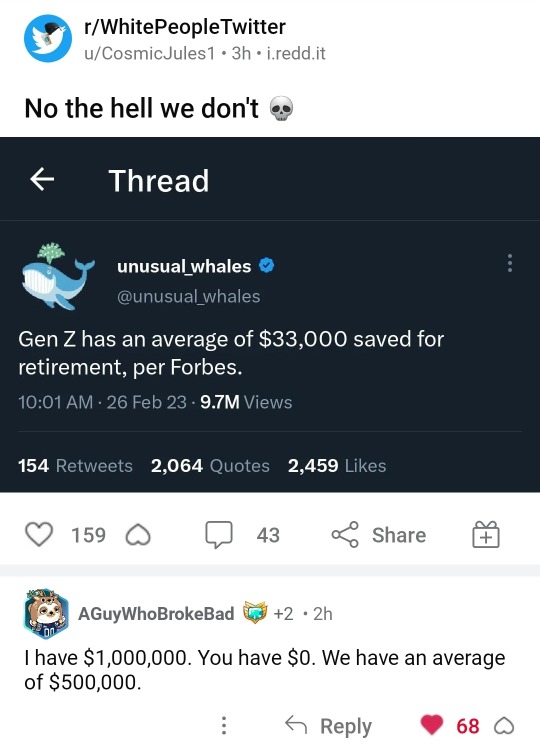#economics
Text
#rainn#economics#2 broke girls#julie kennedy#moominvalley#coquette fashion#snoop dogg#malex#david bowie#maya rudolph
124 notes
·
View notes
Text

SAFETY AS ILLUSION- DANGER AS FRACTURE
1. Connected to the maintenance of life as living death is the second promise of the walls of civilization, the promise of safety.
2. Safety is always illusionary, as the countless attentats, and ever changing airport security protocols reveal- yet its impositions are very solid. Take the traditional wall around a town or settlement (which offers the promise of 'protection from the outside threat- the barbarian); the wall can be undermined, scaled, even broken to pieces if one has time and motivation, it crumbles with age and without constant maintenance and can be bypassed simply by seducing the one who guards it. Yet, to the individual inside the wall, the towering mass of bricks seems both impenetrable and inescapable, and represents a very material disconnect from that which is outside (one cannot for example even see what is outside the walls).
3. Thus the illusion of safety, is stripped bare, not as a form of protection, but as a form of containment; only those who live inside the walls can be convinced of safeties impenetrability- anyone with will enough to exist beyond the walls can see the paper tiger for what it really is- a trap to prevent escape and not a defense against entry.
4. Todays walls are much more diffuse; produced on and in the psychic level in the schools and social relations, the walls are built up inside the minds of individuals who for so many generations have lived inside of them and now no longer need not to see the outside in order to be afraid of it.
5. The illusion of safety has permeated every aspect of daily life, what 'safety' means is never concretely defined; aside from the columns of foot-soldiers patrolling the streets and CCTV at every corner, there is no discursive definition of what it might mean to be 'safe' and no concrete description of what the danger really is.
6. Even radical milieus have adopted these logics, with demands for 'safe space', policies defining safety, and the imagining that one can create places or communities free from the 'dangers' of the outside world.
7. Safety is always premised in imaginary dangers- usually the dangers of the outside, the 'other', or most often mortality. In the name of being kept alive any number of repressive measures become normalized.
8. To assist or allow suicide is still illegal in most of the world[4], the cages of the mental hospitals and prisons are filled with individuals who present a 'danger' to the life of themselves or others.
9. The demand for safety, always walks hand in hand with the forces of domination. Be that tradition of Radical Feminism which demanded 'safer streets' for women against masked and racialized attackers (and resulted in huge police incursions into poor and racialized communities), or the push by LGBT charities for hate crime legislation to protect individuals from street harassment/harm (and which has been used as a 'catchall legislation' that sees vast increases in incarceration and penal punishments for as little as saying 'fuck' in a public space).[5]
10. A fitting example of the anthropocentric obsession with safety is the 'house cat'; a being for whom the entirety of its existence is passed within the confined walls of an apartment. Premised on the idea that the dangers of the outside world; getting lost, starving to death, being run over by a car- are so terrifying (from the human captors point of view) as to justify the ultimate cruelty and curtailment of freedom. The cat is kept entirely 'safe', in a sterile environment which cannot harm her; and yet can one say honestly that a being for whom long nights, restless hunts, a shrugging disregard for humanity are normal character traits- the four walls of a human made prison will bring her happiness?
11. The 'house cat' also serves as fitting analogy for our own lives- the masters of domination keep us safely contained in the cities, the workplace, the homes; and we may wriggle a little, excited by the promise of the gym or the swimming pool- but to go outside, truly outside of their world is not only forbidden but now impossible. We welcome the crushing wheels of the car or the neighbors dog to carry us away- danger signifies freedom.
12. Individuals oscillate between captor and captive as they internalize and reproduce the logic of safety. From the cop on the street corner, to the parent warning its children of the dangers of pedophiles, to the liberal queer askewing violent or confrontational action and enforcing passivity in the name of 'inclusivity'.
13. Individuals of this epoch must face the fact that nowhere is 'safe', and that anyone promising to provide safety is in fact only (re)producing captivity.
14. When entangled with the enforcers of safety- (the police or their representatives) one soon becomes aware, that the illusion of safety is not some absolute safety from harm, but some imagined parameter of safety defined by the apparatchiks and algorithms of domination.
15. When falling fowl of the enforces of safety, one quickly realities that their version of 'keeping you safe' in fact means keeping you under control, or more often saving you from imagined danger so that they can inflict their own very real harm upon you.
16. One can for example be stopped for driving the car too fast, for passing a red light too early, for trying to jump from a bridge, for exploring and abandoned warehouse, or for engaging in a physical confrontation, in all the examples the behavior will first been defined as 'dangerous' and the narrative usually follows "we are here to protect you". Naturally the moment one is in the hands of those enforcers of safety, she can expect to be beaten, tortured, confined in a cage, sexually assaulted, humiliated, bullied and harmed in any myriad of unnameable ways.
17. "Keeping you safe" is synonymous with maintaining the monopoly of danger, harm and violence.
18. It benefits domination to have as many imaginary dangers as possible at play in any given moment. The more, and scarier the dangers, the greater the playground for imagining ways to ensure 'safety'.
19. The ever increasing number of dangers which the civilized order is happy to integrate into its logic- be that the threat of terrorism, ecological disaster, petty crime, homophobia, gendered violence or racism justifies an ever increasing number of punishments, containments and cages.
20. In many 'liberal democracies' we see how the response to popular awareness of structural oppression has been to criminalize any individuals who are accused of perpetuating it (ignoring the reality that the state is always the biggest perpetrator). From hate crime legislation protecting 'oppressed minorities' to attempts to ban networks like tor (because thats where terrorists live) we see time and time again that the promise to keep us free from danger, warped into the very real application of harm.
21. The illusion of safety rests on a very fluid understanding or what and who represent danger. In the logic of domination, we are presented daily with the idea, that a heavily armed gang, enshrined with the right to murder, kidnap, rape, and torture (the police) are 'safe' and that some kid running a red light or walking whilst black represents danger.
22. This is further complicated by status's awarded to individuals based on presumed compliance/non compliance- the refugee is 'safe' the illegal immigrant is dangerous, the steel worker is 'safe' the sex worker is dangerous, the law abiding citizen is 'safe' the criminal is dangerous. The arbitrary awarding of the right to safety is in fact the real danger.
23. Such arbitrary awarding, mean that In the name of safety we have armed hooligans patrolling the streets with assault rifles- and one can go to jail for carrying a kitchen knife from store to homestead.
24. Anyone who believes, we are safe inside the walls is delusional at best and more likely suicidal.
25. Some 'good citizens' (white, rich, cis, hetro, law abiding) might be able to uphold the lie that they are safe inside the walls (even if they discount the toxic fumes and radio waves slowly annihilating them); but even they will be forced to admit their mistake when in the name of 'safety' they cannot leave their home cage except to go their (re)productive one.
26. More than all of this though, why do we need to be safe? Why have we allowed a fear of danger to incubate inside our minds and proliferate in our praxis? Do we even really know what we mean when we say we want to be safe? We are trapped in illusions curated by tyrants.
27. Safety might be illusionary, but danger can be very real. Not the imaginary dangers domination feeds its subjects in order to keep them servile- but the danger which domination itself lives in constant fear of.
28. To break from captivity, is to accept danger into ones life- not the false dangers which preclude safety; but the real dangers of active confrontation with those who claim to provide it (safety). Accepting real danger, means arming conflictuality against the state, the police, technology, pacifistic ideologues, and perhaps even oneself- it is the realization that even if nothing is worth dying/going to jail for, these possibilities are perhaps less terrifying than remaining safe (i.e. captive).
29. To perpetuate the illusion of safety, into every aspect of life is always the goal of domination, every time one arms conflictuality, imbues danger, creates fracture; safety will rush to plug the breach. Just as one has almost no chance of destroying civilization, there is little hope of destroying safety in its totality; one can chip away, and expand ruptures but one must always be prepared that the ruptures will create new forms, and enforcements of safety- the battle will be an endless one.
30. The fight against safety in and of itself, creates danger for the one who pursues it.
31. If one is to truly realize the illusion of safety, and from this realization act in order to destroy it; she must first welcome danger as a constant friend and companion.
32. Through the process of becoming dangerous, she must face the very real dangers inside the walls (repression, assault, murder), and open her heart to all the possible imaginary ones outside of them.
33. Domination will be at every door when one opens herself fully to danger. It will close tight ranks all around and try to force safety at any cost on the one who seeks it.
34. Danger must embody all the fear of the unknown, all the visceral terror of the lands outside the walls, it must plunge deep into the darkness and never shine a light.
35. If danger spreads, 'safety' will wither.
#organization#revolution#anarchism#daily posts#communism#anti capitalist#anti capitalism#late stage capitalism#anarchy#anarchists#libraries#leftism#social issues#economy#economics#climate change#anarchy works#environmentalism#environment#solarpunk#anti colonialism#mutual aid#Let.Me.Die#let me die#pandas technology and the end of the world#bellatrix black#down & out distro
27 notes
·
View notes
Text
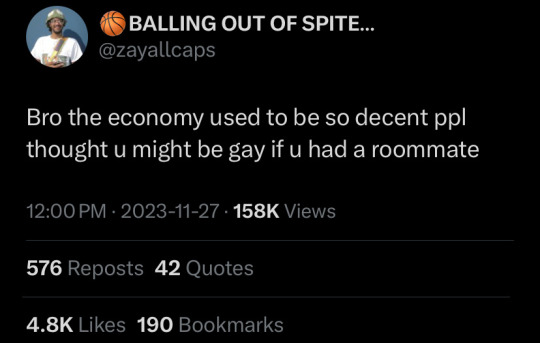
#lgbt#lgbtq#lgbtqia#economics#economy#capitalism#politics#twitter#tweets#tweet#meme#memes#funny#lol#humor
72K notes
·
View notes
Text
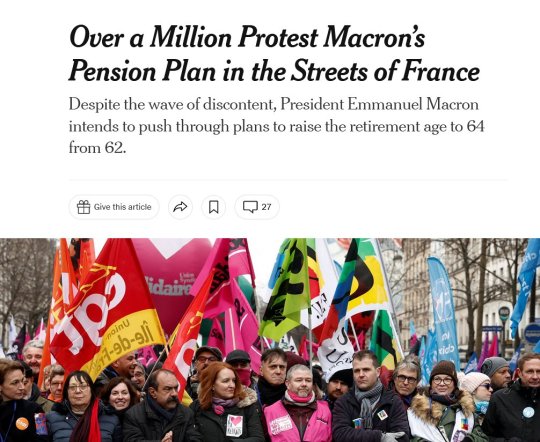
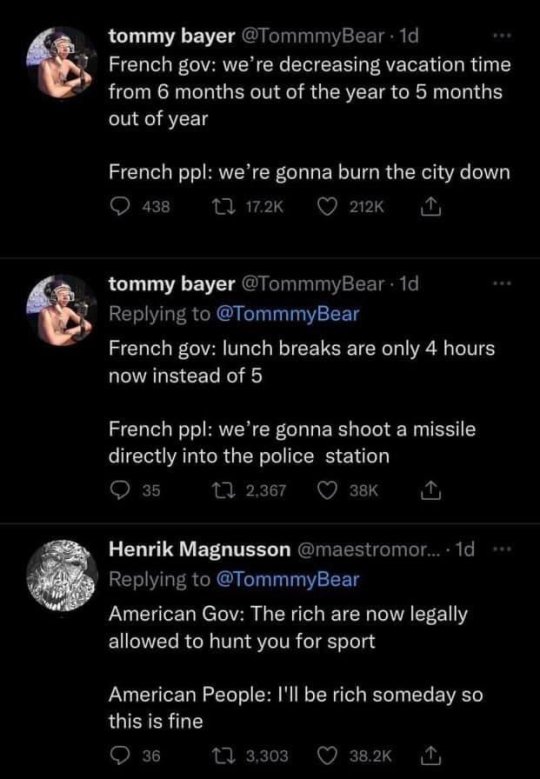
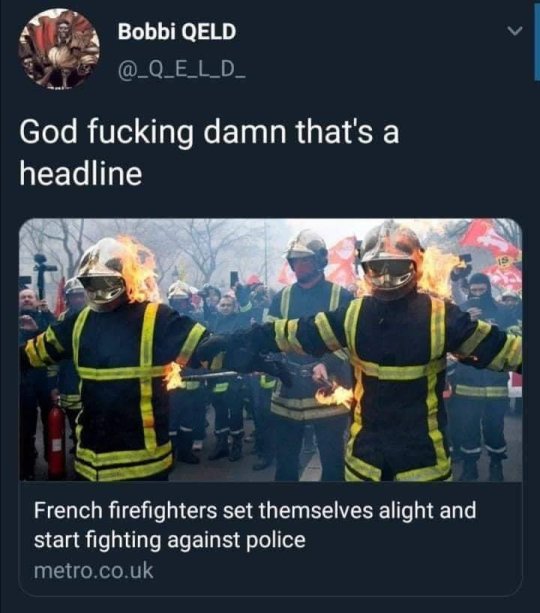
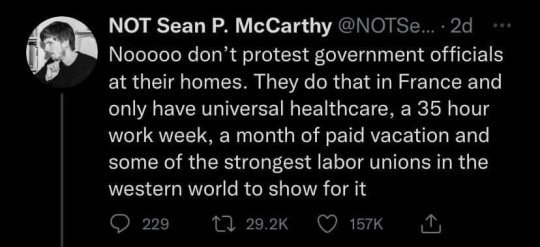
The French really don’t fuck around.
#France#emmanuel macron#capitalism#socialism#america#usa#democrats#republicans#gop#twitter#economics#fox news#pensions#macron
205K notes
·
View notes
Text

#twitter#tweet#tweets#boomers#economics#economy#homeless#class politics#generational politics#class#inequality#wealth inequality
45K notes
·
View notes
Text

#gya#queer#lgbt#lgbtqia#dank memes#dark humor#economics#economy#politics#us politics#tweet#twitter#funny#lol#haha#humor#meme#memes
15K notes
·
View notes
Text
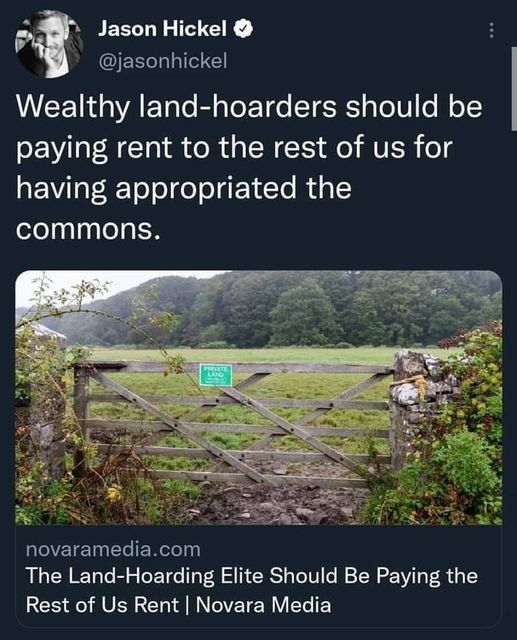
20K notes
·
View notes
Text
I feel like a good shorthand for a lot of economics arguments is "if you want people to work minimum wage jobs in your city, you need to allow minimum wage apartments for them to live in."
"These jobs are just for teenagers on the weekends." Okay, so you'll use minimum wage services only on the weekends and after school. No McDonald's or Starbucks on your lunch break.
"They can get a roommate." For a one bedroom? A roommate for a one bedroom? Or a studio? Do you have a roommate to get a middle-wage apartment for your middle-wage job? No? Why should they?
"They can live farther from city center and just commute." Are there ways for them to commute that don't equate to that rent? Living in an outer borough might work in NYC, where public transport is a flat rate, but a city in Texas requires a car. Does the money saved in rent equal the money spent on the car loan, the insurance, the gas? Remember, if you want people to take the bus or a bike, the bus needs to be reliable and the bike lanes survivable.
If you want minimum wage workers to be around for you to rely on, then those minimum wage workers need a place to stay.
You either raise the minimum wage, or you drop the rent. There's only so long you can keep rents high and wages low before your workforce leaves for cheaper pastures.
"Nobody wants to work anymore" doesn't hold water if the reason nobody applies is because the commute is impossible at the wage you provide.
94K notes
·
View notes
Photo



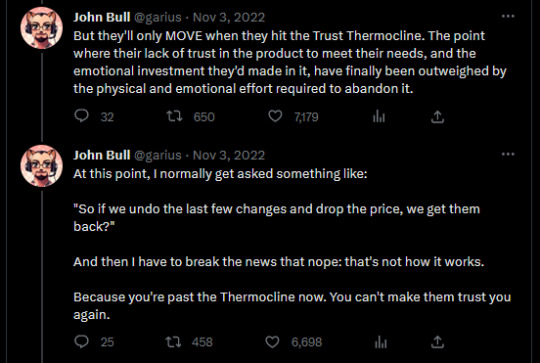
Really good Twitter thread originally about Elon Musk and Twitter, but also applies to Netflix and a lot of other corporations.
Full thread. Text transcription under cut.
John Bull @garius
One of the things I occasionally get paid to do by companies/execs is to tell them why everything seemed to SUDDENLY go wrong, and subs/readers dropped like a stone. So, with everything going on at Twitter rn, time for a thread about the Trust Thermocline /1
So: what's a thermocline?
Well large bodies of water are made of layers of differing temperatures. Like a layer cake. The top bit is where all the the waves happen and has a gradually decreasing temperature. Then SUDDENLY there's a point where it gets super-cold.
That suddenly is important. There's reasons for it (Science!) but it's just a good metaphor. Indeed you may also be interested in the "Thermocline of Truth" which a project management term for how things on a RAG board all suddenly go from amber to red.
But I digress.
The Trust Thermocline is something that, over (many) years of digital, I have seen both digital and regular content publishers hit time and time again. Despite warnings (at least when I've worked there). And it has a similar effect. You have lots of users then suddenly... nope.
And this does effect print publications as much as trendy digital media companies. They'll be flying along making loads of money, with lots of users/readers, rolling out new products that get bought. Or events. Or Sub-brands.
And then SUDDENLY those people just abandon them.
Often it's not even to "new" competitor products, but stuff they thought were already not a threat. Nor is there lots of obvious dissatisfaction reported from sales and marketing (other than general grumbling). Nor is it a general drift away, it's just a sudden big slide.
So why does this happen? As I explain to these people and places, it's because they breached the Trust Thermocline.
I ask them if they'd been increasing prices. Changed service offerings. Modified the product.
The answer is normally: "yes, but not much. And everyone still paid"
Then I ask if they did that the year before. Did they increase prices last year? Change the offering? Modify the product?
Again: "yes, but not much."
The answer is normally: "yes, but not much. And everyone still paid."
"And the year before?"
"Yes but not much. And everyone still paid."
Well, you get the idea.
And here is where the Trust Thermocline kicks in. Because too many people see service use as always following an arc. They think that as long as usage is ticking up, they can do what they like to cost and product.
And (critically) that they can just react when the curve flattens
But with a lot of CONTENT products (inc social media) that's not actually how it works. Because it doesn't account for sunk-cost lock-in.
Users and readers will stick to what they know, and use, well beyond the point where they START to lose trust in it. And you won't see that.
But they'll only MOVE when they hit the Trust Thermocline. The point where their lack of trust in the product to meet their needs, and the emotional investment they'd made in it, have finally been outweighed by the physical and emotional effort required to abandon it.
At this point, I normally get asked something like:
"So if we undo the last few changes and drop the price, we get them back?"
And then I have to break the news that nope: that's not how it works.
Because you're past the Thermocline now. You can't make them trust you again.
56K notes
·
View notes
Text
Every single craft has been paying “The Passion Tax” for generations. This term (coined by author and organizational psychologist Adam Grant) — and backed by scientific research — simply states that the more someone is passionate about their work, the more acceptable it is to take advantage of them. In short, loving what we do makes us easy to exploit.
Guest Column: If Writers Lose the Standoff With Studios, It Hurts All Filmmakers
#quotes#writing#economics#capitalism#the passion tax#adam grant#writers#wga#wga strong#writers strike
26K notes
·
View notes
Text
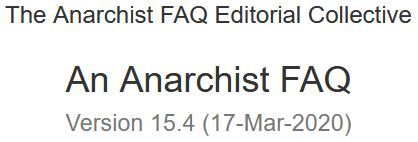
A.3.8 What is “anarchism without adjectives”?
In the words of historian George Richard Esenwein, “anarchism without adjectives” in its broadest sense “referred to an unhyphenated form of anarchism, that is, a doctrine without any qualifying labels such as communist, collectivist, mutualist, or individualist. For others, … [it] was simply understood as an attitude that tolerated the coexistence of different anarchist schools.” [Anarchist Ideology and the Working Class Movement in Spain, 1868–1898, p. 135]
The originator of the expression was Cuban born Fernando Tarrida del Marmol who used it in November, 1889, in Barcelona. He directed his comments towards the communist and collectivist anarchists in Spain who at the time were having an intense debate over the merits of their two theories. “Anarchism without adjectives” was an attempt to show greater tolerance between anarchist tendencies and to be clear that anarchists should not impose a preconceived economic plan on anyone — even in theory. Thus the economic preferences of anarchists should be of “secondary importance” to abolishing capitalism and the state, with free experimentation the one rule of a free society.
Thus the theoretical perspective known as “anarquismo sin adjetives” (“anarchism without adjectives”) was one of the by-products of a intense debate within the movement itself. The roots of the argument can be found in the development of Communist Anarchism after Bakunin’s death in 1876. While not entirely dissimilar to Collectivist Anarchism (as can be seen from James Guillaume’s famous work “On Building the New Social Order” within Bakunin on Anarchism, the collectivists did see their economic system evolving into free communism), Communist Anarchists developed, deepened and enriched Bakunin’s work just as Bakunin had developed, deepened and enriched Proudhon’s. Communist Anarchism was associated with such anarchists as Elisee Reclus, Carlo Cafiero, Errico Malatesta and (most famously) Peter Kropotkin.
Quickly Communist-Anarchist ideas replaced Collectivist Anarchism as the main anarchist tendency in Europe, except in Spain. Here the major issue was not the question of communism (although for Ricardo Mella this played a part) but a question of the modification of strategy and tactics implied by Communist Anarchism. At this time (the 1880s), the Communist Anarchists stressed local (pure) cells of anarchist militants, generally opposed trade unionism (although Kropotkin was not one of these as he saw the importance of militant workers organisations) as well as being somewhat anti-organisation as well. Unsurprisingly, such a change in strategy and tactics came in for a lot of discussion from the Spanish Collectivists who strongly supported working class organisation and struggle.
This conflict soon spread outside of Spain and the discussion found its way into the pages of La Revolte in Paris. This provoked many anarchists to agree with Malatesta’s argument that ”[i]t is not right for us, to say the least, to fall into strife over mere hypotheses.” [quoted by Max Nettlau, A Short History of Anarchism, pp. 198–9] Over time, most anarchists agreed (to use Nettlau’s words) that “we cannot foresee the economic development of the future” [Op. Cit., p. 201] and so started to stress what they had in common (opposition to capitalism and the state) rather than the different visions of how a free society would operate. As time progressed, most Communist-Anarchists saw that ignoring the labour movement ensured that their ideas did not reach the working class while most Collectivist-Anarchists stressed their commitment to communist ideals and their arrival sooner, rather than later, after a revolution. Thus both groups of anarchists could work together as there was “no reason for splitting up into small schools, in our eagerness to overemphasise certain features, subject to variation in time and place, of the society of the future, which is too remote from us to permit us to envision all its adjustments and possible combinations.” Moreover, in a free society “the methods and the individual forms of association and agreements, or the organisation of labour and of social life, will not be uniform and we cannot, at this moment, make and forecasts or determinations concerning them.” [Malatesta, quoted by Nettlau, Op. Cit., p. 173]
Thus, Malatesta continued, ”[e]ven the question as between anarchist-collectivism and anarchist-communism is a matter of qualification, of method and agreement” as the key is that, no matter the system, “a new moral conscience will come into being, which will make the wage system repugnant to men [and women] just as legal slavery and compulsion are now repugnant to them.” If this happens then, “whatever the specific forms of society may turn out to be, the basis of social organisation will be communist.” As long as we “hold to fundamental principles and … do our utmost to instil them in the masses” we need not “quarrel over mere words or trifles but give post-revolutionary society a direction towards justice, equality and liberty.” [quoted by Nettlau, Op. Cit., p. 173 and p. 174]
Similarly, in the United States there was also an intense debate at the same time between Individualist and Communist anarchists. There Benjamin Tucker was arguing that Communist-Anarchists were not anarchists while John Most was saying similar things about Tucker’s ideas. Just as people like Mella and Tarrida put forward the idea of tolerance between anarchist groups, so anarchists like Voltairine de Cleyre “came to label herself simply ‘Anarchist,’ and called like Malatesta for an ‘Anarchism without Adjectives,’ since in the absence of government many different experiments would probably be tried in various localities in order to determine the most appropriate form.” [Peter Marshall, Demanding the Impossible, p. 393] In her own words, a whole range of economic systems would be “advantageously tried in different localities. I would see the instincts and habits of the people express themselves in a free choice in every community; and I am sure that distinct environments would call out distinct adaptations.” [“Anarchism”, Exquisite Rebel, p. 79] Consequently, individualist and communist anarchist “forms of society, as well as many intermediations, would, in the absence of government, be tried in various localities, according to the instincts and material condition of the people … Liberty and experiment alone can determine the best forms of society. Therefore I no longer label myself otherwise than ‘Anarchist’ simply.” [“The Making of An Anarchist”, The Voltairine de Cleyre Reader, pp. 107–8]
These debates had a lasting impact on the anarchist movement, with such noted anarchists as de Cleyre, Malatesta, Nettlau and Reclus adopting the tolerant perspective embodied in the expression “anarchism without adjectives” (see Nettlau’s A Short History of Anarchism, pages 195 to 201 for an excellent summary of this). It is also, we add, the dominant position within the anarchist movement today with most anarchists recognising the right of other tendencies to the name “anarchist” while, obviously, having their own preferences for specific types of anarchist theory and their own arguments why other types are flawed. However, we must stress that the different forms of anarchism (communism, syndicalism, religious etc) are not mutually exclusive and you do not have to support one and hate the others. This tolerance is reflected in the expression “anarchism without adjectives.”
One last point, some “anarcho”-capitalists have attempted to use the tolerance associated with “anarchism without adjectives” to argue that their ideology should be accepted as part of the anarchist movement. After all, they argue, anarchism is just about getting rid of the state, economics is of secondary importance. However, such a use of “anarchism without adjectives” is bogus as it was commonly agreed at the time that the types of economics that were being discussed were anti-capitalist (i.e. socialistic). For Malatesta, for example, there were “anarchists who foresee and propose other solution, other future forms of social organisation” than communist anarchism, but they “desire, just as we do, to destroy political power and private property.” “Let us do away,” he argued, “with all exclusivism of schools of thinking” and let us “come to an understanding on ways and means, and go forwards.” [quoted by Nettlau, Op. Cit., p. 175] In other words, it was agreed that capitalism had to be abolished along with the state and once this was the case free experimentation would develop. Thus the struggle against the state was just one part of a wider struggle to end oppression and exploitation and could not be isolated from these wider aims. As “anarcho”-capitalists do not seek the abolition of capitalism along with the state they are not anarchists and so “anarchism without adjectives” does not apply to the so-called “anarchist” capitalists (see section F on why “anarcho”-capitalism is not anarchist).
This is not to say that after a revolution “anarcho”-capitalist communities would not exist. Far from it. If a group of people wanted to form such a system then they could, just as we would expect a community which supported state socialism or theocracy to live under that regime. Such enclaves of hierarchy would exist simply because it is unlikely that everyone on the planet, or even in a given geographical area, will become anarchists all at the same time. The key thing to remember is that no such system would be anarchist and, consequently, is not “anarchism without adjectives.”
#faq#anarchy faq#revolution#anarchism#daily posts#communism#anti capitalist#anti capitalism#late stage capitalism#organization#grassroots#grass roots#anarchists#libraries#leftism#social issues#economy#economics#climate change#climate crisis#climate#ecology#anarchy works#environmentalism#environment#solarpunk#anti colonialism#mutual aid#cops#police
21 notes
·
View notes
Text
I love when newspapers are like "why are people so pessimistic about the economy when stocks are up and inflation is slowing?" Maybe because stocks mean next to nothing to the average person? Maybe because inflation slowing down still leaves it astronomically high when wages haven't kept up pace? Maybe because rents and housing in general have increased far beyond normal inflation and people are only left with the choice to pay up or be homeless? Maybe because most people's lives are still a complete hellscape in the real world regardless of the theoretical numbers on your little spreadsheet????
10K notes
·
View notes
Text

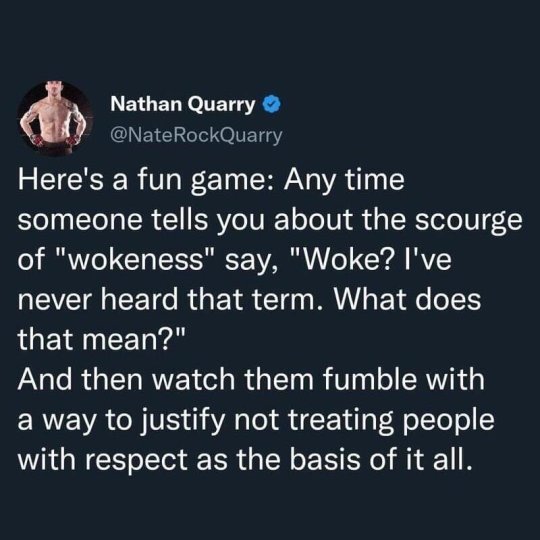
82K notes
·
View notes
Text
What kind of bubble is AI?

My latest column for Locus Magazine is "What Kind of Bubble is AI?" All economic bubbles are hugely destructive, but some of them leave behind wreckage that can be salvaged for useful purposes, while others leave nothing behind but ashes:
https://locusmag.com/2023/12/commentary-cory-doctorow-what-kind-of-bubble-is-ai/
Think about some 21st century bubbles. The dotcom bubble was a terrible tragedy, one that drained the coffers of pension funds and other institutional investors and wiped out retail investors who were gulled by Superbowl Ads. But there was a lot left behind after the dotcoms were wiped out: cheap servers, office furniture and space, but far more importantly, a generation of young people who'd been trained as web makers, leaving nontechnical degree programs to learn HTML, perl and python. This created a whole cohort of technologists from non-technical backgrounds, a first in technological history. Many of these people became the vanguard of a more inclusive and humane tech development movement, and they were able to make interesting and useful services and products in an environment where raw materials – compute, bandwidth, space and talent – were available at firesale prices.
Contrast this with the crypto bubble. It, too, destroyed the fortunes of institutional and individual investors through fraud and Superbowl Ads. It, too, lured in nontechnical people to learn esoteric disciplines at investor expense. But apart from a smattering of Rust programmers, the main residue of crypto is bad digital art and worse Austrian economics.
Or think of Worldcom vs Enron. Both bubbles were built on pure fraud, but Enron's fraud left nothing behind but a string of suspicious deaths. By contrast, Worldcom's fraud was a Big Store con that required laying a ton of fiber that is still in the ground to this day, and is being bought and used at pennies on the dollar.
AI is definitely a bubble. As I write in the column, if you fly into SFO and rent a car and drive north to San Francisco or south to Silicon Valley, every single billboard is advertising an "AI" startup, many of which are not even using anything that can be remotely characterized as AI. That's amazing, considering what a meaningless buzzword AI already is.
So which kind of bubble is AI? When it pops, will something useful be left behind, or will it go away altogether? To be sure, there's a legion of technologists who are learning Tensorflow and Pytorch. These nominally open source tools are bound, respectively, to Google and Facebook's AI environments:
https://pluralistic.net/2023/08/18/openwashing/#you-keep-using-that-word-i-do-not-think-it-means-what-you-think-it-means
But if those environments go away, those programming skills become a lot less useful. Live, large-scale Big Tech AI projects are shockingly expensive to run. Some of their costs are fixed – collecting, labeling and processing training data – but the running costs for each query are prodigious. There's a massive primary energy bill for the servers, a nearly as large energy bill for the chillers, and a titanic wage bill for the specialized technical staff involved.
Once investor subsidies dry up, will the real-world, non-hyperbolic applications for AI be enough to cover these running costs? AI applications can be plotted on a 2X2 grid whose axes are "value" (how much customers will pay for them) and "risk tolerance" (how perfect the product needs to be).
Charging teenaged D&D players $10 month for an image generator that creates epic illustrations of their characters fighting monsters is low value and very risk tolerant (teenagers aren't overly worried about six-fingered swordspeople with three pupils in each eye). Charging scammy spamfarms $500/month for a text generator that spits out dull, search-algorithm-pleasing narratives to appear over recipes is likewise low-value and highly risk tolerant (your customer doesn't care if the text is nonsense). Charging visually impaired people $100 month for an app that plays a text-to-speech description of anything they point their cameras at is low-value and moderately risk tolerant ("that's your blue shirt" when it's green is not a big deal, while "the street is safe to cross" when it's not is a much bigger one).
Morganstanley doesn't talk about the trillions the AI industry will be worth some day because of these applications. These are just spinoffs from the main event, a collection of extremely high-value applications. Think of self-driving cars or radiology bots that analyze chest x-rays and characterize masses as cancerous or noncancerous.
These are high value – but only if they are also risk-tolerant. The pitch for self-driving cars is "fire most drivers and replace them with 'humans in the loop' who intervene at critical junctures." That's the risk-tolerant version of self-driving cars, and it's a failure. More than $100b has been incinerated chasing self-driving cars, and cars are nowhere near driving themselves:
https://pluralistic.net/2022/10/09/herbies-revenge/#100-billion-here-100-billion-there-pretty-soon-youre-talking-real-money
Quite the reverse, in fact. Cruise was just forced to quit the field after one of their cars maimed a woman – a pedestrian who had not opted into being part of a high-risk AI experiment – and dragged her body 20 feet through the streets of San Francisco. Afterwards, it emerged that Cruise had replaced the single low-waged driver who would normally be paid to operate a taxi with 1.5 high-waged skilled technicians who remotely oversaw each of its vehicles:
https://www.nytimes.com/2023/11/03/technology/cruise-general-motors-self-driving-cars.html
The self-driving pitch isn't that your car will correct your own human errors (like an alarm that sounds when you activate your turn signal while someone is in your blind-spot). Self-driving isn't about using automation to augment human skill – it's about replacing humans. There's no business case for spending hundreds of billions on better safety systems for cars (there's a human case for it, though!). The only way the price-tag justifies itself is if paid drivers can be fired and replaced with software that costs less than their wages.
What about radiologists? Radiologists certainly make mistakes from time to time, and if there's a computer vision system that makes different mistakes than the sort that humans make, they could be a cheap way of generating second opinions that trigger re-examination by a human radiologist. But no AI investor thinks their return will come from selling hospitals that reduce the number of X-rays each radiologist processes every day, as a second-opinion-generating system would. Rather, the value of AI radiologists comes from firing most of your human radiologists and replacing them with software whose judgments are cursorily double-checked by a human whose "automation blindness" will turn them into an OK-button-mashing automaton:
https://pluralistic.net/2023/08/23/automation-blindness/#humans-in-the-loop
The profit-generating pitch for high-value AI applications lies in creating "reverse centaurs": humans who serve as appendages for automation that operates at a speed and scale that is unrelated to the capacity or needs of the worker:
https://pluralistic.net/2022/04/17/revenge-of-the-chickenized-reverse-centaurs/
But unless these high-value applications are intrinsically risk-tolerant, they are poor candidates for automation. Cruise was able to nonconsensually enlist the population of San Francisco in an experimental murderbot development program thanks to the vast sums of money sloshing around the industry. Some of this money funds the inevitabilist narrative that self-driving cars are coming, it's only a matter of when, not if, and so SF had better get in the autonomous vehicle or get run over by the forces of history.
Once the bubble pops (all bubbles pop), AI applications will have to rise or fall on their actual merits, not their promise. The odds are stacked against the long-term survival of high-value, risk-intolerant AI applications.
The problem for AI is that while there are a lot of risk-tolerant applications, they're almost all low-value; while nearly all the high-value applications are risk-intolerant. Once AI has to be profitable – once investors withdraw their subsidies from money-losing ventures – the risk-tolerant applications need to be sufficient to run those tremendously expensive servers in those brutally expensive data-centers tended by exceptionally expensive technical workers.
If they aren't, then the business case for running those servers goes away, and so do the servers – and so do all those risk-tolerant, low-value applications. It doesn't matter if helping blind people make sense of their surroundings is socially beneficial. It doesn't matter if teenaged gamers love their epic character art. It doesn't even matter how horny scammers are for generating AI nonsense SEO websites:
https://twitter.com/jakezward/status/1728032634037567509
These applications are all riding on the coattails of the big AI models that are being built and operated at a loss in order to be profitable. If they remain unprofitable long enough, the private sector will no longer pay to operate them.
Now, there are smaller models, models that stand alone and run on commodity hardware. These would persist even after the AI bubble bursts, because most of their costs are setup costs that have already been borne by the well-funded companies who created them. These models are limited, of course, though the communities that have formed around them have pushed those limits in surprising ways, far beyond their original manufacturers' beliefs about their capacity. These communities will continue to push those limits for as long as they find the models useful.
These standalone, "toy" models are derived from the big models, though. When the AI bubble bursts and the private sector no longer subsidizes mass-scale model creation, it will cease to spin out more sophisticated models that run on commodity hardware (it's possible that Federated learning and other techniques for spreading out the work of making large-scale models will fill the gap).
So what kind of bubble is the AI bubble? What will we salvage from its wreckage? Perhaps the communities who've invested in becoming experts in Pytorch and Tensorflow will wrestle them away from their corporate masters and make them generally useful. Certainly, a lot of people will have gained skills in applying statistical techniques.
But there will also be a lot of unsalvageable wreckage. As big AI models get integrated into the processes of the productive economy, AI becomes a source of systemic risk. The only thing worse than having an automated process that is rendered dangerous or erratic based on AI integration is to have that process fail entirely because the AI suddenly disappeared, a collapse that is too precipitous for former AI customers to engineer a soft landing for their systems.
This is a blind spot in our policymakers debates about AI. The smart policymakers are asking questions about fairness, algorithmic bias, and fraud. The foolish policymakers are ensnared in fantasies about "AI safety," AKA "Will the chatbot become a superintelligence that turns the whole human race into paperclips?"
https://pluralistic.net/2023/11/27/10-types-of-people/#taking-up-a-lot-of-space
But no one is asking, "What will we do if" – when – "the AI bubble pops and most of this stuff disappears overnight?"

If you'd like an essay-formatted version of this post to read or share, here's a link to it on pluralistic.net, my surveillance-free, ad-free, tracker-free blog:
https://pluralistic.net/2023/12/19/bubblenomics/#pop

Image:
Cryteria (modified)
https://commons.wikimedia.org/wiki/File:HAL9000.svg
CC BY 3.0
https://creativecommons.org/licenses/by/3.0/deed.en
--
tom_bullock (modified)
https://www.flickr.com/photos/tombullock/25173469495/
CC BY 2.0
https://creativecommons.org/licenses/by/2.0/
4K notes
·
View notes
